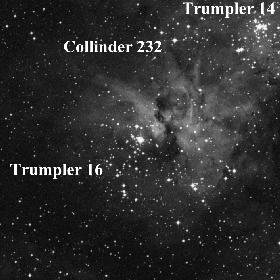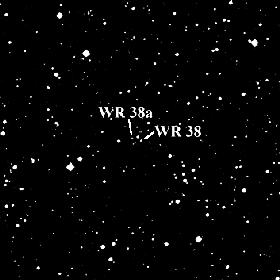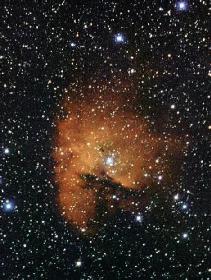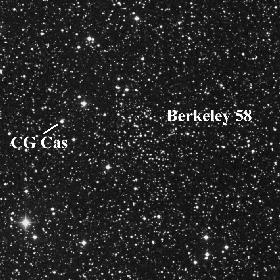Views of Selected Open Clusters


The region at upper left is the 20-arcminute-diameter southern sky field
centred on the rich Eta Carinae Nebula. It contains some of the youngest known
stars and open clusters, including Eta Carinae itself, an exotic superluminous
variable that brightened considerably about a hundred and fifty years ago. All
three clusters in the field appear to be only about a million years old, and
are roughly 8800 light years distant. At upper right is a spatially adjacent
10-arcminute-diameter field of Carina centred on two Wolf-Rayet stars: WR38, of
type WC4, and WR38a, of type WN6. Steve Shorlin, who recently (1998) completed
his M.Sc. thesis under my supervision, studied the field as part of his thesis
research by means of CCD imaging obtained with the University of Toronto's
Helen Sawyer Hogg telescope on Cerro Las Campanas. He found a previously
undetected cluster of young, luminous, OB stars, 41,000 light years distant,
containing the two Wolf-Rayet stars. They appear faintly in the image. It is
the first time that both types of Wolf-Rayet stars have been found in the same
cluster, which indicates a close similarity in age and luminosity for the two
stars.


The cluster at upper left is IC 1590, a glorious young cluster embedded in
the red glowing hydrogen gas of the H II region NGC 281. The field is about 30
arcminutes across. The molecular clouds and hydrogen gas associated with NGC
281 have long been favourite objects of study at radio and infrared
wavelengths, but the cluster remained relatively overlooked at optical
wavelengths prior to an investigation by Harry Guetter (U.S. Naval Observatory)
and me, published in 1997. Shown at upper right is the 15-arcminute-diameter
field of the sparse open cluster Berkeley 58. The cluster would likely remain
unstudied, were it not for the presence of the 4-day Cepheid CG Cas roughly 5
arcminutes from the cluster centre. The two appear likely to be associated, in
which case a determination of the distance to Berkeley 58 through main-sequence
fitting can provide estimates for the luminosity and reddening of CG Cas.
Clusters of this type are key calibrators for the Cepheid period-luminosity (PL)
relation. Click here for a list of open clusters,
multiple systems, and associations that contain Cepheids as potential members.



